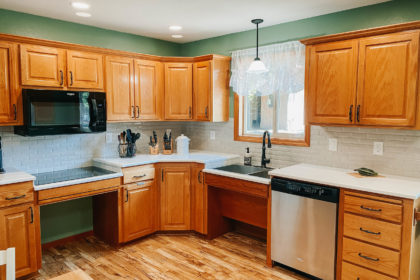
Being able to thrive in your own home as you grow older is a goal for many of us – and with the right preparation, it is possible to create a safe and comfortable environment that supports you now and in the future. If you’re thinking about aging in place, this guide is a good place to start learning about it! We’ll examine big picture concerns and room-by-room details to consider as you begin preparing your home!
While reading through this checklist, take note of what items your home needs. A few easily installed safety features might be all that’s missing, or you may realize some remodeling is in order. Here are a few paths you may take as you prepare your home:
- Adding or upgrading safety features in your home.
- Complete one large project in addition to adding smaller safety features.
- Take on a large remodel to create the perfect, forever home.
- Decide to downsize to a smaller home or design and build your forever home from scratch.
ROOM BY ROOM
Kitchen
A well-designed kitchen can make daily tasks easier, safer, and more comfortable for you now and in the future! Here’s what we would suggest you include in your kitchen:
- Lighting above and below cabinetry and toe-kick lighting
- Shallow sinks
- Drawers on base cabinets or rollout shelves
- Pullout pantry shelving
- Rounded-edge countertops
- Include appliances for universal design
Depending on what needs you or your loved ones may have, we would also suggest a layout that allows for a wheelchair to freely maneuver, clearance below sinks and workstations for walkers and wheelchairs, and to include table-height seating.
Bathrooms
One of the most frequently used spaces in the home is also a wet zone, which means slips and falls can occur here more easily than other rooms in the home. These features will make your bathroom safer and more accessible:
- A spacious shower with no threshold makes it easy for a walker or wheelchair to navigate
- Clearance below sinks for wheelchair and walker access
- Comfort-height toilet
- Lighting at the vanity, shower, tub and toe-kicks
- Grab bars throughout the space, including by the toilet, shower, and bath
Laundry Room
Consider elevating your washer and dryers to avoid excessive bending while doing laundry. Additionally, it’s ideal to have your laundry room on the main floor, rather than the basement (for example).
Bedrooms
As far as modifications go, bedrooms usually don’t need too many changes! Have ample space around furniture and when you’re ready, adding grab bars around the bed can be helpful.
If your master bedroom is currently not on the min floor, you’ll need to consider solutions for stairways. Here’s 3 possible solutions:
- Add a master suite to the main floor. You can repurpose the old master suite into a guest suite!
- Install an elevator or chair lift.
- Downsize to a single-story home.
BIG PICTURE
Throughout the Home
In addition to the room-specific features we mentioned above, it’s a good idea to consider how whole home systems can support (or hinder) your aging in place goals. Here are a few more items to consider:
- Nonslip flooring throughout the home – we think LVP is a great option
- Any rugs should be securely attached to avoid slipping
- Home should be free of clutter and other tripping hazards
- Good lighting should be present throughout the home, including night lighting
- Include security features to both deter intruders and easily call for help
Size and Cost
Maintaining and renovating a larger home can wind up costing you more in the long-term, but if you plan to have children or grandkids move-in or hire a live-in caretaker, it can make sense to keep a spacious home for your many visitors! On the flip side, it’s important to consider the cost of materials and labor has increased in recent years. Sometimes it makes sense to downsize and start fresh in a new home to better fit your needs.
Exterior
You’ll also want to consider the exterior of your home. Larger lots can become challenging and costly to maintain in the years to come. Here are a few exterior features that can help support you:
- At least one, barrier-free entry with ramps as needed.
- The driveaway, walkways, and porches are all in good repair.
- Exterior stairways are secured with sturdy railings and nonslip treads.
- Paths and stairways are well lit.
- Trees are regularly maintained.
- Motion-activated lighting.
Locations and Lifestyle
Your home’s location has a huge impact on your lifestyle and will determine everything from how often you’re able to get together with friends and family to the ease of commuting to the doctor or to run errands. Here’s a brief list of things to keep in mind when it comes to location and lifestyle when aging in place:
- Proximity to friends and family – how many loved ones live nearby?
- Walkability – is there anything within easy walking distance of your home?
- Transportation – do you have easy access to transportation or is public transportation available?
- Climate – are extreme weather conditions a concern?
- Businesses and services – how easy will it be to access quality health care and other services you may need?
Have additional questions that this guide didn’t cover? Mitch is a Certified Universal Design Professional and is happy to help our clients address their home so they can enjoy it – and thrive – for years to come. We can’t wait to help you and your family achieve your goals!